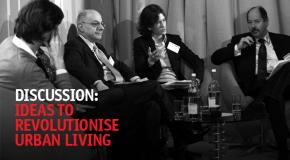There is no doubt that the lives of cities and of the businesses located in them are inextricably intertwined. But how closely linked are cities' economic growth and their liveability?
A survey of urban professionals conducted by the Economist Intelligence Unit shows that the idea of liveability has a number of different components. Jobs and cost of living, public transport and roads, safety and security and culture and nightlife all rank highly among our respondents' list of factors contributing to a city's attractiveness as a place to live and work.
In the first report in this series, we spelled out the strategies policymakers need to adopt in order to maintain and improve liveability for citizens. Some of the key steps include providing a good public transport system, getting a bigger say in planning policy, taking a more sensitive approach to urban design and handing over more control of public services to citizens. This second report explores the relationship between business performance and liveability in cities, and highlights some of the ways in which business and policymakers are working together to make cities more liveable.
Whatever the type of challenge being faced by an individual city, improving liveability can only help to strengthen its attractiveness for residents, workers and potential investors. But coming up with a realistic and effective strategy for boosting economic growth is a hugely difficult challenge, particularly when wider economic forces are working in the opposite direction. History has shown that long-term shifts in patterns of trade across the globe and the introduction of new technologies or production methods can undermine the industries upon which some cities were built. Declining cities in the former manufacturing heartlands of the north of England and in the "rust belt" of the United States provide powerful evidence of this. And, try as they might, policymakers have frequently found it agonisingly difficult to hold back the tide of change.
Even in those cities where economic growth is occurring, the challenge of enabling this can be enormously complex. Often the problem is that those people already living in high growth areas resent the changes associated with it and try to block the developments and investments—in housing and transport, for example—that are needed to facilitate growth. Rather than blocking growth altogether, however, these kinds of obstructions frequently lead to congestion and affordability problems as more and more people and businesses try to cram into houses, offices and trains that were simply not designed to meet such high levels of demand.
It is important to look at liveability—a misunderstood and often misused term—but equally important to understand that for citizens and companies, there is a clear hierarchy of needs. What is clear from our research is that what business primarily wants from city leadership is policy that helps to stimulate job creation, followed by basic liveability factors such as good infrastructure, schools and so on.
Mayors and civic leaders can occasionally be beguiled by the "softer" aspects of liveability. Opera houses, parks and other assets associated with liveability are all important components of great cities' brands, but getting the basics right first helps cities to compete globally on a more equal footing.
Among the key findings of our research are:
Jobs take precedence over liveability when people are choosing where to locate. Our survey shows that the main reason for urban professionals to move to a city is its jobs market and cost of living. Moreover, respondents say that their organisation's main benefit in being located in their city is its access to talent and labour. But with workforces increasingly prepared to relocate for the best opportunities, there is a question mark over policymakers' ability to develop local skill levels and encourage skilled workers to remain in their city.
Deliver the housing needed to meet demand. As we spelled out in our first report, rising house prices are often seen as a sign of a city's economic success. One important challenge for policymakers who are looking for ways to help maintain their city's economic growth is to make sure that there is enough housing to meet demand in economically dynamic areas. Failure to do so can result in housing affordability problems, dissuading talent from moving from low-performing to high-performing areas. This is not simply an issue for policymakers. As Todd Sinai of the University of Pennsylvania's Wharton School of Business points out, "in a city that's more expensive, the first thing that has to happen is that workers need to get paid more".
Open the door to foreign investment. In difficult economic times, policymakers are often pressured into favouring support for local businesses over foreign companies. But such strategies are not necessarily the right way forward, according to our survey—only 15% of respondents see that as a priority for their civic leaders, as opposed to almost one-third who would prefer it if multinationals were encouraged to set up shop in their city, in order to make it more competitive for business. The presence of multinational companies in a city can raise its image elsewhere, and branding can play a big role in the business life of a city. More than one-half of respondents regard their city's international profile and good reputation as important benefits to their organisation's decision to locate there, and nearly three-quarters believe their city's image helps it to attract important industries.
Enlist the help of the commercial sector. Respondents to our survey consider that it is the public sector that should shoulder most responsibility for services such as public transport and the maintenance of parks and schools. But the business sector already plays a key role in developing cities' liveability, supporting culture, sporting events, healthcare facilities, transport infrastructure and environmental initiatives. As civic leaders face tighter budgets they should be prepared to take the initiative in asking business for more help. The cost to the city of London's ambitious cycle hire scheme, for example, would have been far greater without a substantial investment from Barclays, a bank. Of course, in engaging in philanthropic endeavours an organisation's ambition may largely be to generate brand awareness. But Londoners, for their part, have shown that they are prepared to become two-wheeled advertisements for Barclays in exchange for a more convenient journey around town.
Focus on the basics of urban life – transport, roads, houses, schools and safety. When a city secures a major sporting event such as the Olympic Games, is it a boon for business? Urban professionals don't think so. They think it is far more important to get the basics right by improving public transport and roads, providing better schools and improving safety. CEOs such as FedEx's Fred Smith agree. "Ultimately, you have to have both good economics and good quality of life—they feed each other," he says.

















